I was so not prepared to write this post - I had my month down for June and figured that was plenty of time, finishing papers and everything, but Kat caught my in my distractedness and pulled me out from under a pile of French history books decorated with tons of copies for the British translation market. But here you go, you get my full attention for the time it takes to write this post, then I will go into hiding again.
What is your name? My name is Leonie - and don't worry if you aren't sure how to pronounce that name, the short versions Leo or Löni aren't really any pronunciation friendlier to the English. Though on the net I go by "strandkorbtraum" which is probably an even more confusing name ... it means "wicker beach chair dream"
Where do you live? I live in Mainz, the tiny capital of Rheinland-Pfalz in Germany - so before there are any questions, English is my third language.
Tell us about your family
My family is me
Tell us about how you got interested in quilting.
Hmmm tricky - I did patchwork long before I know that term existed (I came across that in 9th grade English), I started doing some EPP commuting in London, I'm not made to read on the bus. When I got back I really started - "borrowing" my mother's sewing machine - I still have it borrowed though it's my back up now.
first patchwork
How do you organize your fabric stash?
I guess it woudl be easier to explain how I don't organize it. I think everytime I'm done with a sewing spree - you know those crazy times when you pull all your farbic make piles and hold patterns next to them - I organize them back into my fabric cupboard a different way.
Strange fabrics (silc, wool, corduroy) and my cotton is in an old kitchen cupboard: I just saw you can't see the strange fabrics, but the drawers are hidden behind the right door ...
Precuts, UFOs, WIPs and knick-knack are in my red rack:
Who is/are your favorite fabric designers?
I don't think I ever bothered much with designers of fabrics - I buy what I like.
What is one thing you have learned that you wish you knew when you first started quilting?
Do what YOU like!
Rules are there to be broken!
Your quilts are beautiful even if they don't look like in the books or on quilt shows. [And if you don't see it that way, you can always gift them to your parents / granparents, they will love it simply because you made it.]
What is your favorite sewing/quilting tool and why should we all go out and buy it?
My rotary cutter - but I doubt there is anyne not calling one already their own.
Who is your favorite fictional character and why?
V. I. Warshawski - an absolutely fabulous tough Lady, won't follow the rules, fiercly loyal and somehow always gets in trouble, well trouble is her job (invented by Sara Paretsky)
The trio Aibileen, Minny, and Skeeter especially Minny she's outspoken and won't put up with anything (invented by Kathryn Stockett)
And with that I will cut the list short - ok maybe one last one ...
Serenity - a star ship, well I like her whole crew and don't want to decide ... (not that already naming the 5th ficitonal character shows my ability to choose)
And now on to the Tutorial ...
* eighteen (18) - 2,5" squares [prints]
* one (1) - 3,5" square [solid1]
* one (1) - 3,5" square [solid 2]
* one (1) - 4,5" square [solid 3]
* one (1) - 4,5" square [solid 4]
* two (2) - 4" squares [solid 5]
* two (2) - 4" squares [solid 6]
For the 18 little squares use a scrap collection of prints, if you don't have that many different try to get at least 9 together so you can make 2 completely scrappy 9-patches. Yes it would be lovely if you had enough different solids to make 2 completely diferent square-in-a-square parts, but if you don't please don't use the same fabric in the same position, that will at least give it a different look.
How to sew the square in a square blocks:
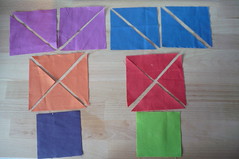 First you need to prepare the farbics by cutting some more.
First you need to prepare the farbics by cutting some more.
Your 4,5" squares need to be cut twice on the diagonals - so you end up with 2 times 4 triangels.
Your 4" squares need to be cut once each on the diagonal - so you end up with 4 triangels for each colour
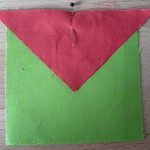
fold the square and the smaller trinagles in half and finger press the middle (give it a good squeeze, or press down on the surface with your nail) - then match the two greases and pin the middle
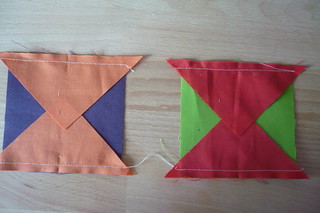
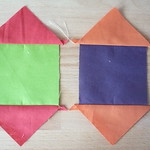 Sew the two opposit triangles to the square then iron them outside (you can in theorie sew them on in radom order but this way it's less ironing time)
Sew the two opposit triangles to the square then iron them outside (you can in theorie sew them on in radom order but this way it's less ironing time)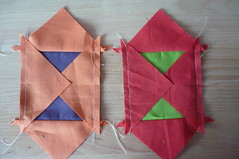
Do the same thing with the other two opposite sides. And press open again. 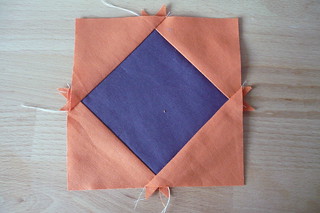
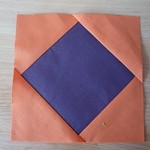 Untrimmed It should measure 5" depending on how accurate you sewed (min was a bit smaller, but that's why we make it a big on the
Untrimmed It should measure 5" depending on how accurate you sewed (min was a bit smaller, but that's why we make it a big on the

 Untrimmed It should measure 5" depending on how accurate you sewed (min was a bit smaller, but that's why we make it a big on the
Untrimmed It should measure 5" depending on how accurate you sewed (min was a bit smaller, but that's why we make it a big on the
large side)
Now this step is really important - you need to trimm down the square to 4 3/4"
You do the same thing again - this time you use your patch square and add the bigger trinagles in exactly the same way. (fold - finger press - pin - sew 2 - iron ...)
Again we (rather I) chose to be on the larger side - trimm it down to 6,5" square
Of course you can use any other way you like to sew that part of the block - just make sure it comes out at 6,5 inch unfinished
Sewing the 2 9-patches: I imagine you don't need me to tell you how to sew a 9-patch together using 2,5" squares? Just use your favourite technique to sew two (2) scrappy 9-patches.
Finishing the block: Just look at the picture for the placement of the 4 parts - but in words:
* the square-in-a-square squares go to the top left, respectively the bottom right
*the 9 patches go to the top right and bottom left.
As a final step - measure your block and see if it's 12,5" square if it isn't hmm I'm sure there is an explanation and an individual solution.
To give you an idea what you are sewing those blocks for - they are going to be an addition to those blocks so I get a really great really big quilt:

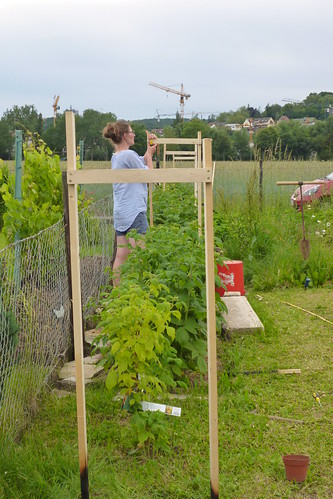
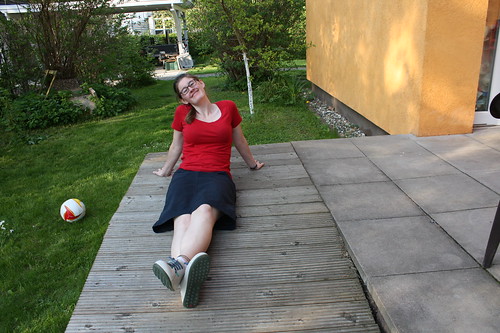

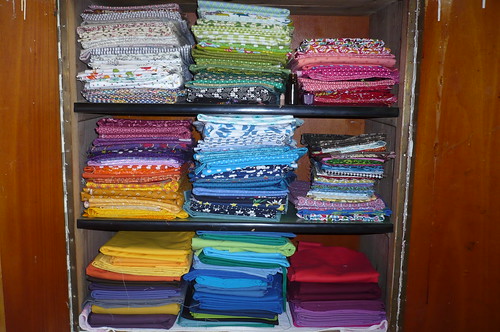
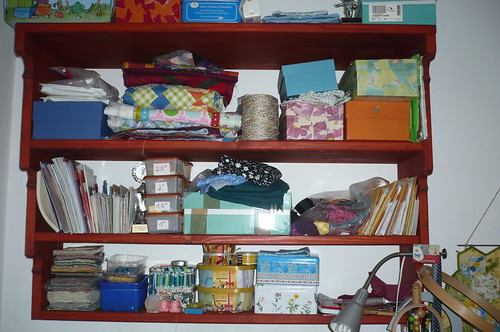
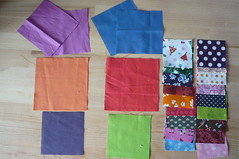

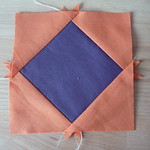
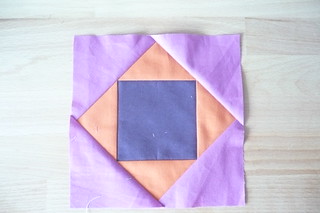

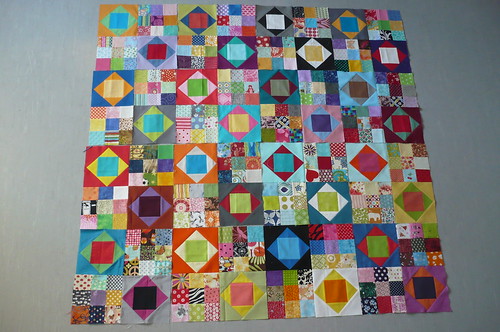
5 comments:
What fun!
Hi stopping by from Hive 11 but this is a really cute idea. I love the whole quilt together. Good choice
Looks great. May have to make them right now. *Runs off to pull fabrics and scraps*
Looks great! Looking forward to putting this together:)
Post a Comment